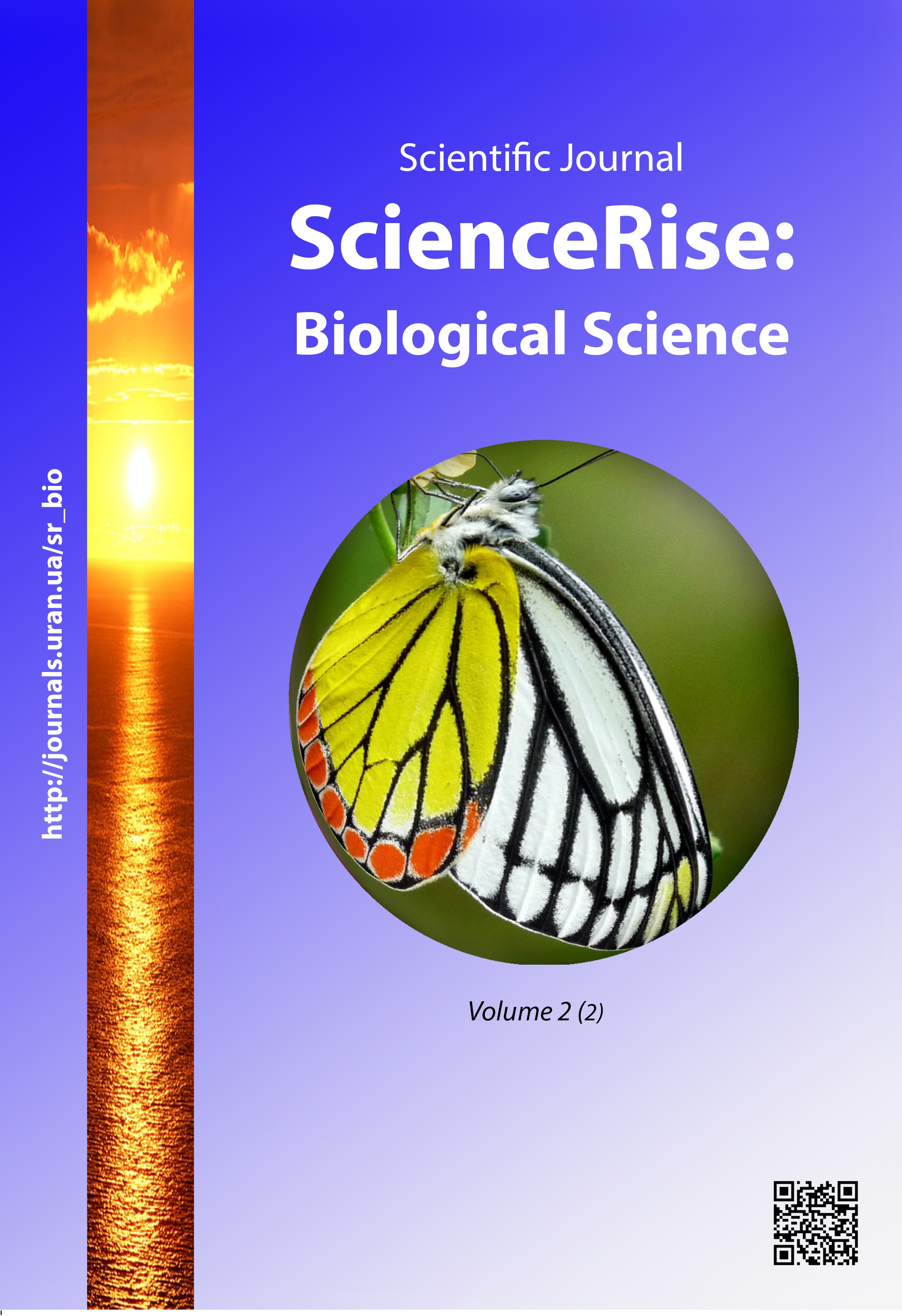Model of spatial structure of human AIMP1/р43 protein
DOI:
https://doi.org/10.15587/2519-8025.2016.81822Keywords:
AIMP1/р43, cytokines, circular dichroism (CD), computer modelingAbstract
Computer modeling of 3D structure of full-length AIMP1/р43 - component of aminoacyl tRNA synthetase complex in higher eukaryotes, was performed. The model of the spatial structure of the dimer AIMP1/р43 was obtained. Experimental data on the content of the secondary structure of AIMP1/р43 was determined by circular dichroism method. The spatial structure of AIMP1/р43 allows to carry out structural and functional analysis of the interaction with other biologically important molecules
References
- Wolfe, C. L., Warrington, J. A., Davis, S., Green, S., Norcum, M. T. (2009). Isolation and characterization of human nuclear and cytosolic multisynthetase complexes and the intracellular distribution of p43/EMAPII. Protein Science, 12 (10), 2282–2290. doi: 10.1110/ps.03147903
- Ivakhno, S. S., Kornelyuk, A. I. (2004). Cytokine-like activities of some aminoacyl-tRNAsynthetases and auxiliary p43 cofactor of aminoacylation reaction and their role in oncogenesis. Exp. Oncol., 26 (4), 250–255.
- Quevillon, S., Agou, F., Robinson, J.-C., Mirande, M. (1997). The p43 Component of the Mammalian Multi-synthetase Complex Is Likely To Be the Precursor of the Endothelial Monocyte-activating Polypeptide II Cytokine. Journal of Biological Chemistry, 272 (51), 32573–32579. doi: 10.1074/jbc.272.51.32573
- Shalak, V., Kaminska, M., Mitnacht-Kraus, R., Vandenabeele, P., Clauss, M., Mirande, M. (2001). The EMAPII Cytokine Is Released from the Mammalian Multisynthetase Complex after Cleavage of Its p43/proEMAPII Component. Journal of Biological Chemistry, 276 (26), 23769–23776. doi: 10.1074/jbc.m100489200
- Fu, Y., Kim, Y., Jin, K. S., Kim, H. S., Kim, J. H., Wang, D. et. al. (2014). Structure of the ArgRS–GlnRS–AIMP1 complex and its implications for mammalian translation. Proceedings of the National Academy of Sciences, 111 (42), 15084–15089. doi: 10.1073/pnas.1408836111
- Renault, L. (2001). Structure of the EMAPII domain of human aminoacyl-tRNA synthetase complex reveals evolutionary dimer mimicry. The EMBO Journal, 20 (3), 570–578. doi: 10.1093/emboj/20.3.570
- Larkin, M. A., Blackshields, G., Brown, N. P., Chenna, R., McGettigan, P. A., McWilliam, H. et. al. (2007). Clustal W and Clustal X version 2.0. Bioinformatics, 23(21), 2947–2948. doi: 10.1093/bioinformatics/btm404
- Ishida, T., Kinoshita, K. (2007). PrDOS: prediction of disordered protein regions from amino acid sequence. Nucleic Acids Research, 35 (Web Server), W460–W464. doi: 10.1093/nar/gkm363
- Dosztanyi, Z., Csizmok, V., Tompa, P., Simon, I. (2005). IUPred: web server for the prediction of intrinsically unstructured regions of proteins based on estimated energy content. Bioinformatics, 21 (16), 3433–3434. doi: 10.1093/bioinformatics/bti541
- Perez-Iratxeta, C., Andrade-Navarro, M. A. (2008). K2D2: Estimation of protein secondary structure from circular dichroism spectra. BMC Structural Biology, 8 (1), 25. doi: 10.1186/1472-6807-8-25
- Louis-Jeune, C., Andrade-Navarro, M. A., Perez-Iratxeta, C. (2011). Prediction of protein secondary structure from circular dichroism using theoretically derived spectra. Proteins: Structure, Function, and Bioinformatics, 80 (2), 374–381. doi: 10.1002/prot.23188
- Eswar, N., Webb, B., Marti-Renom, M. A., Madhusudhan, M. S., Eramian, D., Shen, M. et. al. (2007). Comparative Protein Structure Modeling Using MODELLER. Current Protocols in Protein Science, 2.9.1–2.9.31. doi: 10.1002/0471140864.ps0209s50
- Martí-Renom, M. A., Stuart, A. C., Fiser, A., Sánchez, R., Melo, F., Šali, A. (2000). Comparative Protein Structure Modeling of Genes and Genomes. Annual Review of Biophysics and Biomolecular Structure, 29 (1), 291–325. doi: 10.1146/annurev.biophys.29.1.291
- Xu, D., Zhang, Y. (2011). Improving the Physical Realism and Structural Accuracy of Protein Models by a Two-Step Atomic-Level Energy Minimization. Biophysical Journal, 101 (10), 2525–2534. doi: 10.1016/j.bpj.2011.10.024
- Chen, V. B., Arendall, W. B., Headd, J. J., Keedy, D. A., Immormino, R. M., Kapral, G. J. et. al. (2009). MolProbity: all-atom structure validation for macromolecular crystallography. Acta Crystallographica Section D Biological Crystallography, 66 (1), 12–21. doi: 10.1107/s0907444909042073
- Doreleijers, J. F., Sousa da Silva, A. W., Krieger, E., Nabuurs, S. B., Spronk, C. A. E. M., Stevens, T. J. et. al. (2012). CING: an integrated residue-based structure validation program suite. Journal of Biomolecular NMR, 54 (3), 267–283. doi: 10.1007/s10858-012-9669-7
- Schneidman-Duhovny, D., Inbar, Y., Nussinov, R., Wolfson, H. J. (2005). PatchDock and SymmDock: servers for rigid and symmetric docking. Nucleic Acids Research, 33 (Web Server), W363–W367. doi: 10.1093/nar/gki481
- Comeau, S. R., Gatchell, D. W., Vajda, S., Camacho, C. J. (2003). ClusPro: an automated docking and discrimination method for the prediction of protein complexes. Bioinformatics, 20 (1), 45–50. doi: 10.1093/bioinformatics/btg371
- Pettersen, E. F., Goddard, T. D., Huang, C. C., Couch, G. S., Greenblatt, D. M., Meng, E. C., Ferrin, T. E. (2004). UCSF Chimera?A visualization system for exploratory research and analysis. Journal of Computational Chemistry, 25 (13), 1605–1612. doi: 10.1002/jcc.20084
- Park, S. G., Choi, E. C., Kim, S. (2010). Aminoacyl-tRNASynthetase–Interacting Multifunctional Proteins (AIMPs): A Triad for Cellular Homeostasis. IUBMB Life, 62 (4), 296–302. doi: 10.1002/iub.324
Downloads
Published
How to Cite
Issue
Section
License
Copyright (c) 2016 Дмитро Миколайович Ложко, Іванович Корнелюк Олександр

This work is licensed under a Creative Commons Attribution 4.0 International License.
Our journal abides by the Creative Commons CC BY copyright rights and permissions for open access journals.
Authors, who are published in this journal, agree to the following conditions:
1. The authors reserve the right to authorship of the work and pass the first publication right of this work to the journal under the terms of a Creative Commons CC BY, which allows others to freely distribute the published research with the obligatory reference to the authors of the original work and the first publication of the work in this journal.
2. The authors have the right to conclude separate supplement agreements that relate to non-exclusive work distribution in the form in which it has been published by the journal (for example, to upload the work to the online storage of the journal or publish it as part of a monograph), provided that the reference to the first publication of the work in this journal is included.









